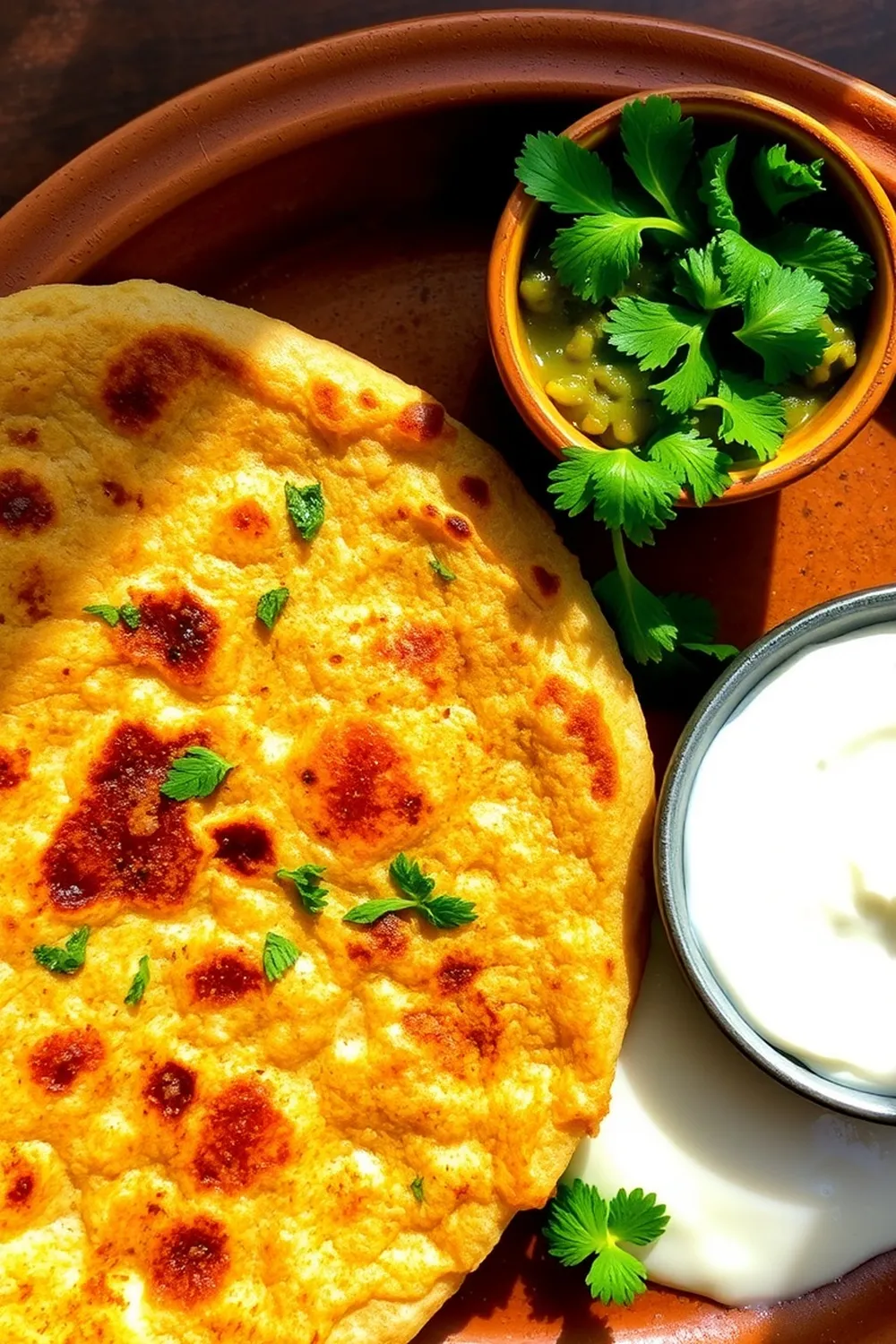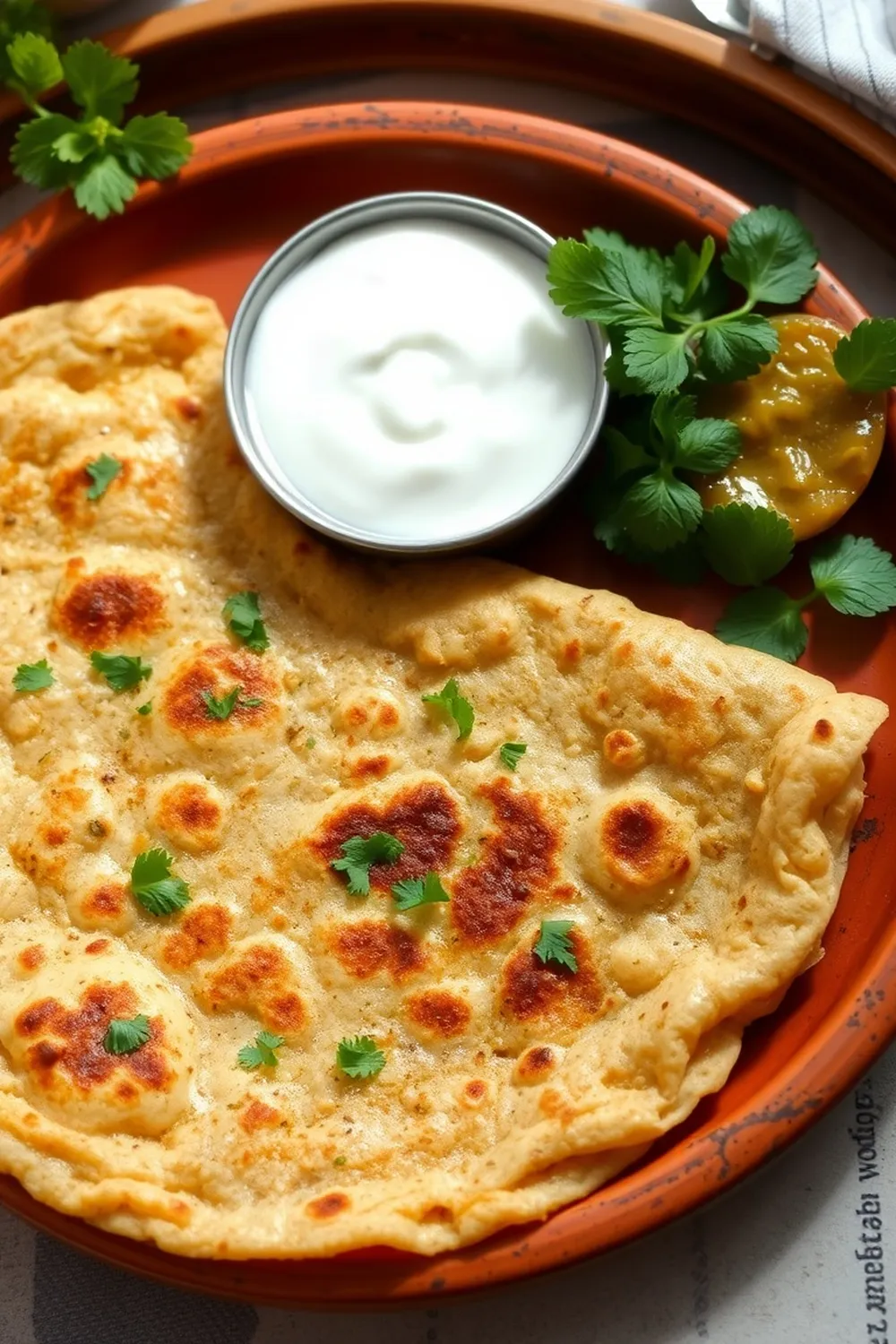- Combine whole wheat flour and salt in a bowl. Gradually add water and knead to form a soft, firm dough. Cover with a damp cloth and rest for at least 30 minutes.
- Mix red chili powder, turmeric powder, coriander powder, saunf powder, cumin powder, garam masala, kasuri methi, and amchur powder in a bowl to create the masala blend.
- Roll a lemon-sized dough ball into a 6-inch circle. Brush with melted ghee and sprinkle the masala mixture evenly over the surface.
- Add chopped mint and coriander leaves on top. Roll the dough tightly into a long cylinder, then coil it into a spiral shape.
- Gently flatten the coil and roll it into a 7-8 inch paratha.
- Heat a tawa or griddle and cook the paratha for 30-60 seconds per side. Drizzle with ghee and roast until golden brown and crisp on both sides.
- Serve warm with yogurt, raita, or a curry of your choice.
- Calories:220 kcal25%
- Energy:920 kJ22%
- Protein:5 g28%
- Carbohydrates:32 mg40%
- Sugar:1 mg8%
- Salt:150 g25%
- Fat:8 g20%
Last Updated on 6 months ago by Neha Deshmukh
Masala Paratha Recipe – Mint & Coriander Indian Flatbread
Hey everyone! If you’re anything like me, you absolutely love a good paratha. There’s just something so comforting about a warm, flaky flatbread stuffed with flavorful spices. This Masala Paratha, bursting with fresh mint and coriander, is a family favorite and I’m so excited to share it with you. It’s perfect for a quick weeknight dinner, a weekend brunch, or even a festive treat!
Why You’ll Love This Recipe
This isn’t just any paratha recipe. It’s a flavor explosion! The combination of aromatic spices, fresh herbs, and flaky whole wheat bread is simply irresistible. Plus, it’s surprisingly easy to make, even if you’re new to Indian cooking. Trust me, once you try this, you’ll be making it again and again.
Ingredients
Here’s what you’ll need to create this deliciousness:
- 2 cups Whole wheat flour (atta)
- 0.5 tsp Salt
- 4-5 tbsp Ghee (clarified butter) – plus extra for cooking
- 3 tbsp Mint leaves, finely chopped
- 5 tbsp Coriander leaves, finely chopped
- 2 tsp Red chili powder
- 0.5 tsp Turmeric powder
- 2 tbsp Coriander powder
- 1 tbsp Saunf powder (fennel seed powder)
- 0.5 tsp Roasted cumin powder
- 0.5 tsp Amchur powder (dried mango powder)
- 2 tsp Kasuri methi (dried fenugreek leaves)
- 0.25 tsp Garam masala powder
Ingredient Notes
Let’s talk ingredients for a sec! Getting these right makes all the difference.
- Whole Wheat Flour Varieties: You can use different types of atta. I prefer the regular whole wheat flour (chapati atta) readily available in most Indian grocery stores.
- The Significance of Ghee in Indian Cooking: Ghee isn’t just about flavor; it adds a beautiful richness and helps create that flaky texture we all love. It’s a staple in Indian kitchens for a reason!
- Understanding Saunf (Fennel Seeds) & Its Flavor Profile: Saunf adds a lovely subtle sweetness and anise-like flavor. Don’t skip it! If you only have fennel seeds, lightly dry roast them and grind them to a powder.
- Kasuri Methi: The Dried Fenugreek Leaf – A Regional Staple: This adds a unique, slightly bitter, and incredibly fragrant flavor. Crush it between your palms before adding it to release its aroma.
- Amchur Powder: The Tangy Secret to North Indian Flavors: This gives a lovely tartness that balances the spices beautifully. It’s made from dried unripe mangoes and is a must-have in your spice rack.
Step-By-Step Instructions
Alright, let’s get cooking!
- First, in a large bowl, combine the whole wheat flour and salt. Slowly add water, a little at a time, and start kneading to form a soft, firm dough. It shouldn’t be sticky!
- Cover the dough with a damp cloth and let it rest for about 10 minutes. This allows the gluten to relax, making the parathas softer.
- While the dough rests, let’s make the masala! In a separate bowl, mix together the red chili powder, turmeric powder, coriander powder, saunf powder, roasted cumin powder, garam masala, kasuri methi, and amchur powder.
- Now, take a lemon-sized ball of dough and roll it into a 6-inch circle. Brush it generously with melted ghee.
- Sprinkle the masala mixture evenly over the ghee-covered dough. Don’t be shy!
- Top with the chopped mint and coriander leaves.
- Carefully roll the dough tightly into a long cylinder, then coil it into a spiral. This is where the magic happens!
- Gently flatten the coil and roll it out into a 7-8 inch paratha. Be gentle so the filling doesn’t spill out.
- Heat a tawa (flat griddle) over medium heat. Place the paratha on the tawa and cook for about 15 seconds per side.
- Drizzle with ghee and roast until golden brown spots appear on both sides. Press gently with a spatula to ensure even cooking.
Expert Tips
- Don’t over-knead the dough. A soft dough is key!
- Use warm water to knead the dough, especially in colder months.
- Rolling the paratha evenly is important for even cooking.
- Keep the heat medium to prevent burning.
Variations
Want to switch things up? Here are a few ideas:
- Vegan Masala Paratha: Substitute the ghee with any vegetable oil.
- Gluten-Free Masala Paratha (Using Alternative Flours): Use a gluten-free atta blend. You might need to adjust the water quantity. My friend, who’s gluten-free, swears by a mix of rice flour and potato starch.
- Spice Level Adjustments (Mild, Medium, Spicy): Adjust the amount of red chili powder to your liking. For a milder flavor, use Kashmiri chili powder for color without the heat.
- Festival Adaptations (Holi, Diwali): These are always a hit during festivals! You can add a pinch of cardamom powder to the masala for a festive touch.
Serving Suggestions
Serve these warm with a dollop of yogurt, a refreshing raita, or your favorite Indian curry. They’re also delicious on their own with a cup of chai!
Storage Instructions
Leftover parathas can be stored in an airtight container in the refrigerator for up to 2 days. Reheat on a tawa or in a microwave. They’re best enjoyed fresh, though!
FAQs
Let’s answer some common questions:
What is the best flour to use for making soft parathas?
Regular whole wheat flour (atta) works best.
Can I make the dough for masala paratha ahead of time?
Yes, you can! Just store it in an airtight container in the refrigerator and bring it to room temperature before rolling.
How can I prevent the paratha from becoming too hard?
Don’t overcook it! And make sure to use enough ghee.
What is the purpose of using ghee in this recipe? Can I substitute it?
Ghee adds flavor and helps create a flaky texture. You can substitute it with vegetable oil, but the flavor won’t be quite the same.
Can I add other vegetables to the masala filling?
Absolutely! Finely chopped potatoes, peas, or carrots would be delicious additions.
How do I get the perfect golden-brown color when roasting the paratha?
Use medium heat and drizzle with ghee. Press gently with a spatula to ensure even cooking.










